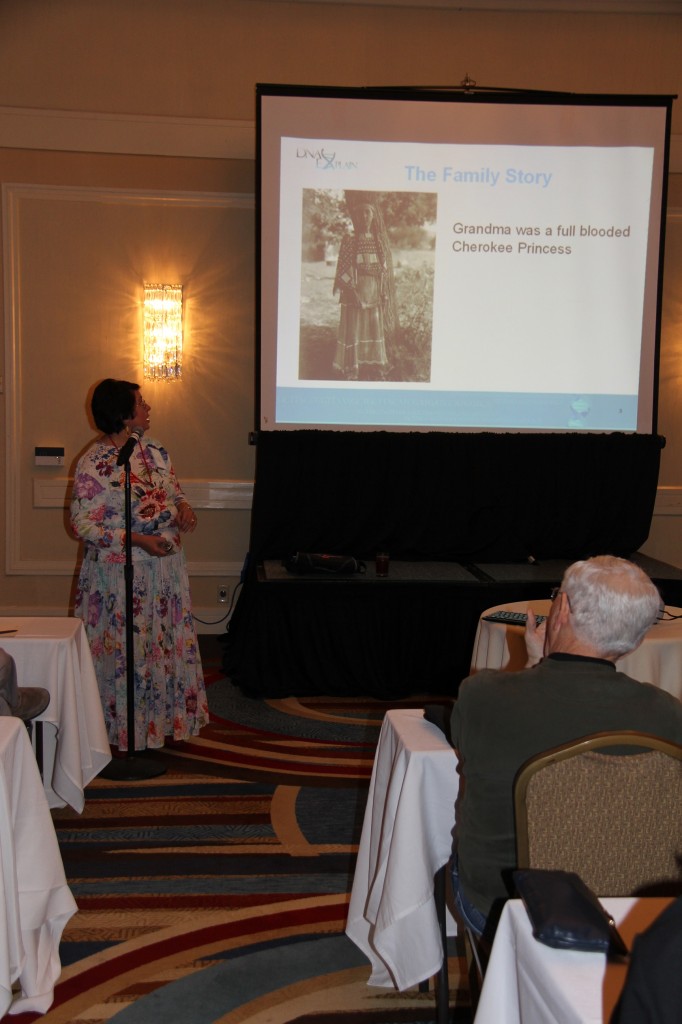Since I’ve already seen Tim Janzen’s Autosomal Mapping presentation and mostly because Roberta Estes is so awesome, I chose to attend her presentation How toFind Your Indian Prince(ss) Without Having to Kiss Too Many Frogs. Roberta says that where there is smoke, there may be fire. It may not be what you think or where you think because stories lose “facts” with each generational retelling.
Historically, “Indians” and “Blacks” were viewed as one because they were people of color. Once held in slavery, freedom had to be approved by the state governing body. Manumitted slaves, Indian, black, or mixed people were second class citizens. They could not own land, vote, testify against whites and were taxed at a higher rate. Tribal Indians were often invisible because they were not taxed. Treaties led to Indian reservations and group land ownership. Until 1835, some Indians and mixed race people could vote, go to school and testify in court.
European expansion led to Indians being pushed off of land. Treaties were broken. Indians were assimilated and removed. The saying “the only good Indian is a dead Indian” was a real thing. In 1830 Andrew Jackson signed the Indian Removal Act forcing removal west of the Mississippi. Indians enslaved were admixed and the same status as other slaves. Disease and assimilation had decimated the eastern tribes. Mixed race people were often, but not always, considered to be “of color”. Tribes lived on reservations and did not pay taxes.
During removal, only Indians on reservations had to go. Mixed race people not on reservations did not have to leave. Indians living on private land did not have to leave. Rolls were taken, but not everyone participated. Cherokees believed the Treaty of Echota was illegal because it was not ratified by the tribe. Being “Indian” was not a good thing in the 1830s and fear was rampant. In 1838 after the Trail of Tears, some of the survivors NEVER spoke again.
Assimilation began as early as Jamestown in 1614 with Pocahontas. Her name was Matoaka and she was baptized and renamed Rebecca Rolfe. Bride ships didn’t arrive until 1620. Assimilation started with slavery. Traders had “Country Wives” in every village that made trading easier. It was a status symbol for females because they got English goods. The Native custom was that when a traveler came, they provided them with a bed mate for the night. This was usually one of the young women who are referred to as “Trader girls”. There was also assimilation with the trader’s slaves. People were kidnapped all the time. This kidnapping went on between tribes, slaves, and whites. Captives were often adopted. There were also traditional marriages and generally the female was Native and the male was European. Roberta does not know of any that were the other way around.
In 1819, one third of white Cherokee tribal members reported to be white females captured as children. In 1835 removal rolls, 211 whites were recorded as “married in” and another 100 were living with the Cherokee. In the 1835 removal rolls, 23% of the tribe was listed as “admixed”.
Indian Princess Grandmas might be admixed through slavery. They might be admixed through assimilation prior to the 1830s or through tribal assimilation. They might have been tribal members in the 1830s. There are rolls from 1830s forward.
Full article here:http://www.ancestorcentral.com/archives/801
© History Chasers Click here to view all recent Historical Melungeons Blog posts
Enter your email address to start receiving this blog in your inbox

No comments:
Post a Comment